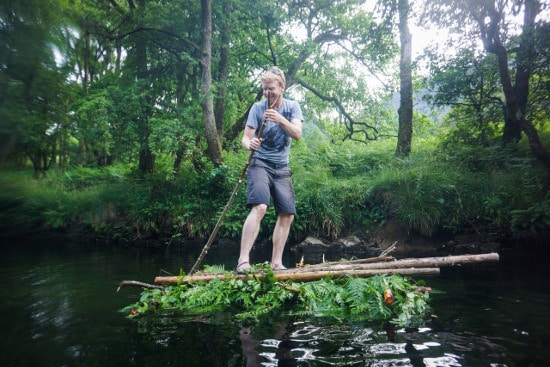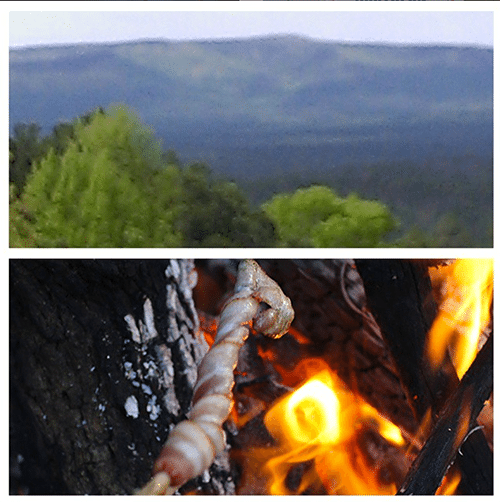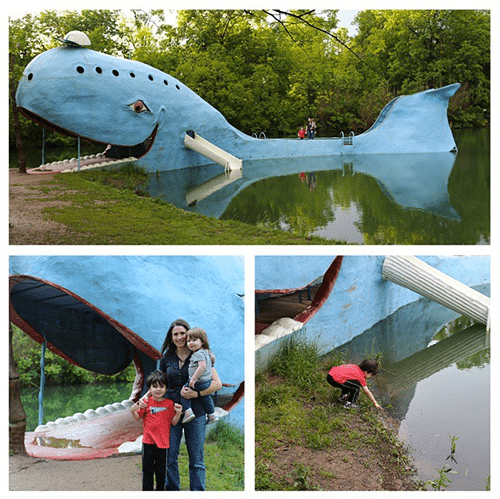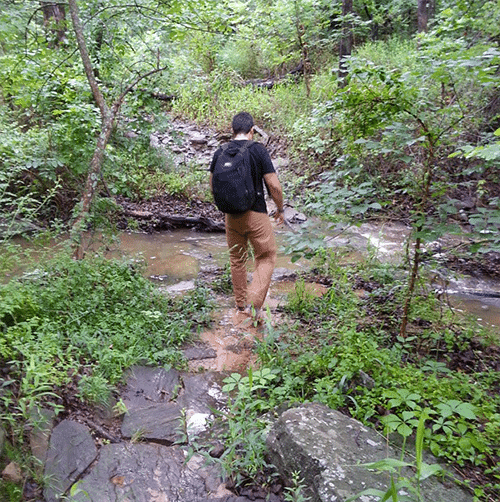
“[Adventure] is a state of mind, a spirit of trying something new and leaving your comfort zone. Adventure is about enthusiasm, ambition, open-mindedness, and curiosity….‘adventure’ is not only crossing deserts and climbing mountains; adventure can be found everywhere, every day, and it is up to us to seek it out.” –Alastair Humphreys, Microadventures
Do you have an itch for more adventure in your life?
Do you want to get out and explore more, but don’t have the time or money to undertake a major, globe-trotting expedition?
Maybe this longing has made you feel frustrated and stuck.
If that sounds like you, allow me to suggest embracing the microadventure.
The term “microadventure” was coined by Alastair Humphreys, a true Adventurer with a capital A. Humphreys has bicycled around the world, walked across India, and rowed across the Atlantic Ocean. And he noticed that whenever he spoke of these travels, listeners would get a look of awe and envy in their eyes and wistfully express how they wished they could take similarly grand adventures. This admission was invariably followed by a list of excuses for why such expeditions were not in the cards — the would-be adventurers lived in suburbs and cities, had jobs and kids, and didn’t have enough money, vacation time, etc.
Humphreys was sympathetic; he understood that it is hard for normal folks to take four years off to cycle around the world. Yet he strongly believed that people from all walks should cultivate the spirit of adventure in their lives.
To address this dilemma, he decided to undertake an experiment: for a year he would seek short, simple, cheap adventures in a place not known for its wild landscape — his home country of England. Rather than setting out on involved, far-flung expeditions, he would regularly take “microadventures” – tiny trips that butted right up against the boundary of what might be called an adventure at all, but still retained the fun, excitement, escapism, and challenge inherent to the essence of true adventures.
Humphreys wanted to bust the seeming barriers and excuses people gave for lacking adventure in their lives; he wanted to show that adventures could be had close to home, fit into a 9-5 schedule, and didn’t require gobs of money, lots of gear, or special training.

Image from Alastair Humphreys
To that end, he squeezed in weekend mountain biking trips, rode the subway out to random patches of countryside where he’d sleep on the ground or atop a hill, took a two-day bike ride down the coast, swam and camped the river Thames, climbed some local mountains, tubed a small waterway near Wales, and hiked in small areas of wilderness. Some of his adventures were longer and more challenging, others more simple; once, he simply curled up in a sleeping bag in the garden outside his backdoor and slept the night in his yard.
At the end of his year of microadventures, Humphreys concluded that his small expeditions had packed a big punch, leaving him feeling rejuvenated and rekindling his boyish spirit. He thinks everyone else needs regular doses of microadventures, too.
So I decided to embark on my own microadventure experiment.
My 8-Week Microadventure Challenge
“[Microadventures are] for aspiring adventurers who are looking for the confidence to kick on to bigger projects, as well as for seasoned adventurers wanting to learn more about their local area or scratch the itch of adventure in between big trips. It’s for people with real jobs and real lives, with a couple of kids and a cat to feed. It’s for people who love reading about adventure, who yearn for adventure, but who think that they are too busy, too old, too fat, or too urbanized to be able to get out there and do it.” –AH
Humphreys wrote a book all about the magic of mini expeditions called, naturally enough, Microadventures. Several people had recommended it to me, and this spring I finally ordered a copy and gave it read. It was wonderfully inspiring, and it seemed clear to me that becoming a microadventurer was something I, and my family, really needed to try.
When it comes to adventure, the McKay family is perhaps not the world’s worst — Kate and I take the kids on nature walks and picnics, and we try to go camping a couple times a year, do occasional obstacle races, and take our vacations in places that offer plenty of outdoor recreation.
Yet more often than not, our big outings on weekends are to Panera Bread and Target.
Oh, I had the usual excuses: I get consumed by my work, Oklahoma’s opportunities for wilderness adventure are nothing to write home about, and it’s hard to get out and do stuff with a one and four-year-old. Just taking our tykes swimming seems to be an involved expedition in and of itself, involving an abundance of outfitting and coordination.
So too, I can’t say my situation was resulting in acute restlessness, nor the feeling of living a life of quiet desperation; I’m by temperament something of a homebody, who enjoys the quiet and the ordinary.
But, I did have something of an itch for just a little more life than I was experiencing. When you have kids, your life undergoes a natural contracting, where you’re inclined to simplify your schedule and hang out more at the home cave. But this narrowing had gone on a little too long, and turned into too much of a stagnant rut. When you and your wife have children, you have to learn how to navigate the world differently — to move and operate as a unit, and I felt like the McKays hadn’t yet mastered that art.
So to scratch my itch, to get the kids out more, for whom I want to inculcate a love of the outdoors, and to gratify Kate, who’s always jonesing for a good outing, I decided to lead our wolf pack through an 8-week microadventure challenge. Each week I, and usually the whole family as well, would undertake one tiny expedition.
Humphreys says adventures must take you out of your comfort zone, and I figured this was to my advantage; mine was already so high, it wouldn’t take much to get me outside it!
Here’s what we did:
“Even in your backyard there are new adventures, new sights, new perspectives: you just have to make the small effort to go and discover them.” –AH
Week 1: Camping and Hiking in the Ouachita Mountains
 To kick off the challenge, I figured we’d do something a little bigger. So Kate and I decided to take a two-day camping trip in the Ouachita Mountains. Just two hours southeast of Tulsa, one can find a whole nother’ landscape of rolling green hills and mountains. When you get out there, you find it hard to believe you’re still in Oklahoma.
To kick off the challenge, I figured we’d do something a little bigger. So Kate and I decided to take a two-day camping trip in the Ouachita Mountains. Just two hours southeast of Tulsa, one can find a whole nother’ landscape of rolling green hills and mountains. When you get out there, you find it hard to believe you’re still in Oklahoma.
We had camped in the area before, but never at the lovely Cedar Lake, where we set up our tent late on a Monday evening (we always camp during the week to avoid crowds). On the agenda for the next day was a new hike too: the Horse Thief Spring trail. As we would discover, the trail is a little roughly cared for in places, but delightfully lonely; we didn’t see another soul the entire way, which is just how we like it.
The loop is supposed to be about 13 miles, but we managed to get lost and ended up hiking for about 18. By the end, we were hot, out of water, quite thirsty, and worried we weren’t going to make it back before nightfall. But we stumbled into camp just as the sun was going down, tired but satisfied.
All in all it was a great, rejuvenating time, and we learned an important lesson about bringing ample water on our hikes!
It was a good little adventure; but we planned for the remaining expeditions to be even more micro and closer to home.
Week 2: Sleeping in the Backyard With Gus

Humphreys argues you can find adventure in your own backyard, and he means it quite literally!
Gus is getting to the age where he’d be fun to take camping, and I figured the first step in getting him comfortable with sleeping outdoors would be to sleep outside in our yard. I’d been meaning to have such a father/son sleepover for awhile; the microadventure challenge pushed me to finally do it. I wondered how he would take to it — would he be weirded out by the nighttime noises, and toss and turn all night, or want to go back inside?
We decided to set up “camp” in a little treehouse loft attached to our swingset. It was just the right size for the double-wide sleeping bag we’d share. We brought out some flashlights and books, and hung out for awhile talking and reading stories before turning in for the night.
Gus? He was out like a light and slept like a rock the whole night through. I turned out to be the one tossing and turning! With squirrels scampering through the leaves and planes flying overhead, it was surprisingly loud out there.
But the twinge of tiredness I experienced the next day was worth it; Gus had loved our campout and couldn’t wait to do it again.
“You should not need to live in a beautiful wilderness to have adventures. My microadventures take place in normal places for normal people.” –AH
Week 3: Visiting the Blue Whale

One of the things that made my 8-week challenge a little more difficult was the record-breaking rain OK received in May. It seemed to rain almost every day that month, which sometimes thwarted our plans.
On one such occasion, we had hoped to do a little local hike with the kids and have a picnic. We shot for executing it during a window when it was supposed to stop raining for a few hours. We knew the ground would be wet, but thought we could eat under a bare pavilion located at the trailhead. But when we got there, the pavement was a giant puddle. Time for plan B.
We had about 2 hours before the kids’ bedtime, and we racked our brains trying to think of another microadventure we could do with little time and minimal planning. Suddenly, it came to me: the Blue Whale of Catoosa.
The Blue Whale is a giant concrete structure that sits on the edge of a pond along historic Route 66. Built in the 70s by a private citizen as an anniversary present for his wife, it’s become a popular public roadside attraction and Oklahoma landmark.
Though I have lived in OK for almost all my life, I had never been to see the whale. I had always imagined it being really far away. But when I pulled up directions, I was surprised and delighted to realize it was only about 25 minutes from our house.
So we all piled in the car and headed out there. It was pretty fun to see. The kids had a great time exploring the inside of the whale, and getting really muddy at the edge of the pond (which we support!). It was just a little trip, but immensely enjoyable.
“Though most of us live in a sanitized, suburbanized, Subway-ized world, we can still escape from it easily whenever we need to feel the rain blowing on our faces and howl at the moon.” –AH
Week 4: Rucking in the Woods
For this week’s microadventure, I kept things really simple. I typically do almost all of my workouts inside at a gym, so I decided to change that up and take a ruck in the woods.
I headed over to Turkey Mountain, which is about 15 minutes from my house. It’s really more of a large hill than a mountain, but this urban wilderness area in the heart of Tulsa boasts 300 acres and a few dozen miles of trails. It’s a real gem.
I slung on my GoRuck pack, along with the 40 lbs of bricks I’ve used for past GoRuck challenges, and spent an hour hoofing it on the trails. I found the hike left me feeling more calm and invigorated than my usual, fluorescent-lit workouts.
“Even the illusion of wildness, those tiny forgotten pockets of it squeezed behind your town, can refresh the soul.” –AH
Week 5: Fishing With Gus and Grandpa

Humphreys advises those who work a 9-5, to make more of their 5-9. It’s very easy to get home from the office, eat dinner, and then piddle around the house until bedtime night after night. So this week I decided we’d do something with our evening hours.
I’d planned on taking Gus fishing, but it had been an especially rainy week, and the weekend looked like more of the same. But just as my workday ended on Friday evening, the skies cleared for awhile, and I thought, “Okay, let’s go fishing right now.” “Right now?” Gus asked, not used to his dad showing spontaneity. “Yup, right now.”
Before we left, I asked Kate’s dad if he wanted to come, as he likes to fish as well, and he too showed some surprising spontaneity in deciding to accompany us.
The whole McKay clan, plus Jaju (phonetic rendering of the Polish word for grandfather) headed to Lake Bixhoma, a small lake about 30 minutes from my house. I had never been there, and it turned out to be quite bucolic. It’s one of those places, where even though you’ve just driven a few miles out of town, you feel as though you’ve really traveled somewhere different.
Kate put Scout in a hiking pack and went exploring around while the boys went fishin’. Alas, no one got a bite, but we all really enjoyed being out there and watching the sun go down on the water.
“Even small woods and forests feel removed from the world. They are almost a separate, parallel domain; like entering Narnia or Wonderland.” –AH
Week 6: Date Night Hike

The gym Kate and I go to provides a regular “Parents Night Out” where you can drop your kids off with their childcare on a Friday night for a few hours. We take advantage of these PNO’s from time to time, usually to go out to eat and browse a bookstore for awhile.
This time, however, we decided to turn date night into a microadventure. After we dropped the kids off at the gym, we drove up to Turkey Mountain. The rain had continued to be relentless, and we ate a picnic dinner on the tailgate of our car since the ground was saturated.
Turkey Mountain has a couple popular trails that start at the trailhead parking lot, and we’ve done them a lot. This time we decided to take a trail that’s a little more out of the way that we had never hiked before.
The rains had turned the trails into little streams. At first we tried to avoid stepping right in the mud and water, but this proved impossible, and isn’t good for the trails anyway. So we resigned ourselves to an evening of splish sploshing through small creeks, which actually turned out to be pretty fun. Our pants got muddy and soaked through, and when we picked up the kids, we agreed that microadventure date night definitely beat dinner and a movie.
Week 7: Late Night Bike Ride
One of the things Humphreys encourages folks to do to find adventure is to look for a way to see a familiar place from a new perspective. One of the best ways to do that, he advises, “is by going somewhere you know very well, but at night.”
In this spirit, Kate and I decided to take a late night bike ride. After the kids had gone to sleep and the sun had gone down, we had Kate’s parents come over and housesit, and we headed out.
I don’t own a bike (evidence of how far my recreation has fallen), but luckily Tulsa has a program where they offer stalls of single-speed bicycles you can check out for free and borrow for a few hours. Unluckily, the stall we chose had only two remaining bikes available, and the unalterable height on the seat of mine was way too low. When I pedaled, my knees practically came up to my chin. But around 9pm, away we went.
We had planned to take a trail that runs along the Arkansas River for much of the way, but it was closed for construction, forcing us to improvise a detour and pedal down some busy streets and through dark neighborhoods. But that was part of the excitement. Less exciting was the heat; it was humid and 89 degrees even with the sun down, and my shirt was soon soaked with sweat.
We made our way to downtown and that was definitely the highlight of the trip. It was cool to cruise the empty streets and see the architecture of Tulsa in a new way.
We got a little lost on our ad-libbed detour back, and finally arrived home at about 11 pm.
The weather and the discomfort of my bike admittedly spoiled my attitude a little during our expedition, but I still felt glad we did it.
Week 8: Rafting the Illinois River
 Kayaking, canoeing, and rafting the Illinois River is a popular pastime in Oklahoma, but I hadn’t floated this picturesque waterway since high school. I figured doing so would be a great way to finish our microadventure challenge.
Kayaking, canoeing, and rafting the Illinois River is a popular pastime in Oklahoma, but I hadn’t floated this picturesque waterway since high school. I figured doing so would be a great way to finish our microadventure challenge.
This was another activity I had thought was rather far away from Tulsa (as it was from where I grew up near OKC), and I was pleasantly surprised to learn we could put in just about an hour away. I bought some life jackets for the kids and a raft (I didn’t make our own out of sticks I’m afraid!), and we ventured up to Tahlequah, OK early one Monday morning (like camping sites, the river gets crowded on the weekends).
We put our raft in where we’d have about a 2-hour float. Neither Gus nor Scout can swim, nor had ever been in a raft, and I had some trepidation that they’d be bored and otherwise dislike the whole thing, and Kate and I’d be trapped aboard a watercraft with two crying, whining kids for the duration. But that exigency never materialized. While there were a few brief bouts of unhappiness as the kids acclimated to the new experience, and a few frightened yelps as we went though some tiny “rapids,” for the most part they calmly endured and enjoyed it by turns.
After the float we got some ice cream, which the kids felt was the highlight of the trip.
We were back in the early afternoon, in time for a half day of work. We all agreed the outing beat our usual Monday morning routine by a mile.
Concluding Thoughts
“Ever since I began taking on these intentionally small ‘expeditions,’ I have discovered that coming up with an interesting plan (and committing to making it happen) is virtually all you need to do to guarantee an interesting, challenging and rewarding experience.” –AH
What turned out to be the most surprising thing about my 8-week microadventure challenge was how unchallenging it was! Breaking out of my routine and doing a tiny expedition each week required very little effort, time, or money at all; the barriers I had imagined to executing such outings turned out to exist only in my mind. That included a worry that Gus and Scout wouldn’t take to some of the activities, and I’d have a pair of whining kids on my hands. Instead, they loved getting out more and exploring, and I learned, as I seemingly have to again and again, that they’re more resilient than I sometimes think.
I can’t say the challenge radically changed my life; microadventures are too small to completely alter the tenor of one’s existence. But I did feel more contented and satisfied overall. One of my favorite parts was simply having something fun to plan and look forward to doing each week. And I really enjoyed exploring more of my local community, and ended up feeling more connected to, and pride in, living in Oklahoma.
Maybe the best part of the challenge was that it pushed us out of the rut we had gotten into. Kate and I have committed to continuing to do one microadventure each week, and doing so has become our new normal; when we’re sitting around the house on a Saturday afternoon, our natural impulse now is to brainstorm something fun to get out and do. And getting our feet wet during the challenge has allowed us to feel ready to take on more challenging microadventures.
As Humphreys writes, the great thing about microadventures is they can be scaled up or down. If you’re childless, or simply already have a higher comfort level, you can seek out more exciting and involved challenges. If you’re super busy and have a lot on your plate, you can find ways to squeeze tiny microadventures into your schedule.
The most important thing, no matter your situation in life, is to realize that chances for adventure are all around you. Don’t think adventure has to wait for a grand global trek, or for the perfect circumstances in your daily life, where you think all your ducks will get in a row, and you’ll be able to start getting out more. In every city there are pockets of wilderness to explore; in every schedule there are pockets of time to utilize.
You just have to realize that adventure is all around you, take the first small step, and make stuff happen.
For more inspiration, and ideas for much sexier microadventures, I highly recommend picking up a copy of Humphreys’ book. He has a website packed with microadventure tips as well. Also, check out our podcast we did with Humphreys about microadventures:
And be sure to check out these sites to easily find new hikes and fun things to do near you:






